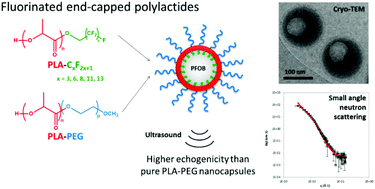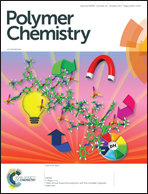End-chain fluorination of polyesters favors perfluorooctyl bromide encapsulation into echogenic PEGylated nanocapsules†
Abstract
Perfluorinated end-capped polylactides (PLAs) with various perfluorinated chain lengths from C3F7 to C13F27 were synthesized and formulated into PEGylated nanocapsules of perfluorooctyl bromide (PFOB) to be used as ultrasound contrast agents (UCAs). We show that the perfluorinated end groups do not reduce the interfacial tension between PFOB and the organic solvent used during formulation and do not allow a significant reduction of shell thickness (Small angle neutron scattering (SANS) experiments). However, the PFOB encapsulation efficiency increases with the fluorinated chain length until C8F17. This suggests the possible presence of favorable fluorophilic interactions between PFOB and perfluorinated end groups. In addition, nanocapsules formulated with different fluorinated polymers do not promote any specific toxicity in vitro compared to non-fluorinated PLAs. Ultrasound imaging performed on samples presenting the lowest thickness values, namely nanocapsules made from 50% PLA-C6F13/50% polylactide-b-poly(ethylene glycol) (PLA-PEG) and pure PLA-PEG nanocapsules, shows that fluorinated nanocapsules exhibit a higher ultrasound contrast enhancement in vitro most probably thanks to the higher PFOB content and density arising from polymer fluorination. This highlights the benefit of fluorination for improving the echogenicity of nano-sized ultrasound contrast agents.



 Please wait while we load your content...
Please wait while we load your content...